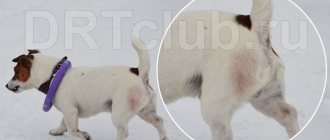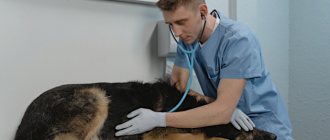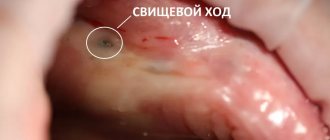Eye diseases in pets are always unpleasant and difficult to treat. One of the most common among them is stye in a dog’s eye. It is characterized by an inflammatory process on the eyelid and associated painful manifestations. The article will analyze in detail the causes of the disease, its types, as well as effective methods of getting rid of it.
Signs
The owner will notice styes that appear on the outside of the eyelid immediately. If it forms inside, then it is of course impossible to see it, but an attentive owner will notice a slightly swollen eyelid, and a slight swelling on the eye. If treatment is not started on time, bacteria will multiply and the eyelid cavity will fill with pus.
After swelling and redness in the eyelash area, after a few days, pus accumulates on the eyelid. After 3-4 days, a yellow-white head forms at the top of the barley. Your dog may have a fever. She will constantly scratch her eye.
After another 3-4 days, the abscess will open, pus and particles of dead tissue will begin to flow out of it. In some cases, an abscess may not form; the swelling will disappear on its own.
Symptoms of stye in dogs
The most obvious symptoms of this condition are:
- lump on the eyelid near the eyelashes
- swelling near the eye
- redness of the whites of the eyes
- discomfort and pain
- discharge from the eyes (watery/thick/smelly)
physical symptoms such as:
- squinting of an infected eye
- rubs and scratches the eye
- blinks frequently
- keeps his eye closed
A stye causes a lot of pain and discomfort to the dog. Most will become restless and constantly try to scratch/rub their eyes, further irritating them and spreading infection into the eye tissue.
Call a veterinarian Moscow
+7(495)162-70-70
Similar symptoms to parasitic or bacterial blepharitis, discoid lupus erythematosus or squamous cell carcinoma can have long-term consequences such as blindness or loss of an eye, so any redness or swelling of your dog's eye or eyelid that persists for more than a day or two should be checked by a veterinarian.
What types are there?
Barley, depending on its location, can be external or internal. The external one is formed on the outside of the eye. In this case, inflammation of the eyelash follicle or sebaceous gland occurs.
Internal styes appear on the inside of the eyelid. As a result, the fatty gland of the cartilaginous plate of the eyelid becomes inflamed.
The size of the formation depends on the state of the animal’s immunity and the degree of infection.
At first it is the size of millet, and then increases. Microbes multiply quickly, which is why purulent inflammation occurs. As a result, the walls of the eyelid become thin, and subsequently the stye resolves or opens.
Reasons for appearance
Barley begins due to the fact that microbes enter the pores of the eyelash follicle or sebaceous gland. The eyelid can become inflamed as a result of any factor that leads to weakened immunity. These include:
- intoxication;
- previous cold or infectious disease;
- skin infection by fungi;
- conjunctivitis;
- hypothermia of the dog's body;
- poor nutrition and vitamin deficiency;
- eye injury;
- high dampness in the room where the animal is kept.
Small dogs are most prone to eye diseases.
Important! It must be borne in mind that due to increased infection, inflammation can spread to nearby tissues of the eyelids and eyes.
Treatment
Inside
Before treatment, you need to determine the type of barley. Internal stye cannot be treated on your own because in this case serious procedures may be required. Most often education:
- open with a scalpel;
- washed with a special solution;
- treated with an antiseptic.
Outside
You can try to cure external stye yourself. Treatment includes maintaining hygiene, eye drops, and anti-inflammatory ointments.
First of all, both eyes, regardless of the fact that the formation is located only on one, are washed with Furacilin. Then Tetracycline or Hydrocortisone ointment is applied to the eyelid 5 times a day.
Drugs
Antibiotic eye drops help enhance the effect of treatment:
- Levomycytin;
- Desacid;
- Iris.
They are dripped for 2 weeks 3 times a day only after a veterinarian’s prescription.
It is forbidden to pierce the purulent crust in order to squeeze out the stye, as the infection can penetrate deep into the eye, which often leads to the development of meningitis or sepsis.
The method of treating a sore spot with 70-degree medical alcohol is considered risky.
Several, on the upper or lower eyelid
If several styes appear on an animal’s eyelids at once, then you should definitely visit a veterinarian. In this case, most often local treatment will not help. The dog is prescribed a course of immunostimulants and antibiotics, with further opening of the styes.
Traditional methods
Barley is also treated with traditional methods, namely dry heat. It can be a boiled, peeled egg, which is wrapped in a clean napkin or cloth, and then applied to the sore spot.
But this procedure is done only when there is no purulent head. Otherwise, when the stye opens, pus will flow into the eye.
Your veterinarian may prescribe the use of cortisone, which helps reduce swelling and inflammation of the skin. Preparations containing this substance are most often used to treat old dogs. The appearance of barley is a constant problem for them and most often there is no improvement with other medications.
Basically, these formations disappear after treatment, but if this does not happen, and they interfere with the dog’s vision, the veterinarian proceeds with removal. The manipulation is carried out with a scalpel or a simple syringe and always a sterilized needle.
Before the procedure, the dog is given a sedative and the eye area is cleaned with a special composition. During the operation, you will need to put a muzzle on it so that it does not bite the owner and the doctor.
Keratitis
Keratitis is an inflammation of the cornea (the most superficial, transparent layer of the eye in contact with the external environment), manifested by the appearance of individual areas of cloudiness or clouding of the entire cornea, which can lead to decreased vision and, in advanced cases, to blindness.
There are:
- Shepherd dog keratitis (the disease is typical for shepherd dogs, but it is also often found in Staffordshire terriers, Labradors and mixed breeds, somewhat less often in other breeds: collies, St. Bernards, Siberian huskies, huskies, Airedale terriers, Russian greyhounds, greyhounds).
- Boxer keratitis (boxers, Boston terriers, French bulldogs, Pekingese, pugs).
- Dachshund keratitis.
Shepherd keratitis, or pannus, is a superficial, usually without ulceration, chronic inflammation of the cornea.
Symptoms:
- On the conjunctiva (normally pink) - extensive brown pigmentation appears.
— Gray-white clouding of the cornea and the formation of a red shaft, due to the appearance of blood vessels, which spreads over the surface of the cornea over time and is prone to pigmentation.
— Often combined with changes in the third eyelid: plasmoma of the third eyelid (depigmentation of the edge of the eyelid is observed, it thickens).
— Erosion of the cornea from the nasal part of the eye is observed.
Treatment:
1. Lifelong. Local preparations with antibiotics and anti-inflammatory components.
2. Many dogs have a good effect when using ointment with cyclosporine (Optimmune) or tacrolimus (Protopic).
3. In case of loss of vision due to damage to the cornea and severe cases that cannot be treated, surgical intervention (superficial keratotomy) is required.
Boxer's keratitis, or chronic non-healing corneal erosion, Boxer's ulcer is a chronic superficial ulcerative keratitis.
Symptoms:
— At the beginning, a minor defect of the cornea appears, invisible to the naked eye, later it becomes whitish, and erosion appears.
— The dog squints its eye (blepharospasm), it becomes watery (less often, purulent discharge).
— Vessels appear, due to which in some cases the surface of the eye appears red.
Treatment:
1. Long lasting. Local preparations with broad-spectrum antibiotics at least 6 times a day.
2. Surgical removal of lagging epithelium of the cornea.
Dachshund keratitis.
Symptoms:
— At an early stage, local irritation and pinpoint opacities are observed, which are colored green with a special diagnostic dye—fluorescein. Sometimes transparent pits are visible on the surface of the cornea (these are ulcers covered with epithelium).
— As the disease progresses further, blood vessels appear on the cornea (vascularization) and the cornea becomes red in color.
- In the later stages, there is a gray-pink cloudiness on the surface of the cornea, the cornea loses transparency, pigmentation of the cornea appears (it becomes brown), and dry eye syndrome often develops.
Treatment:
1. Long lasting. Local preparations with broad-spectrum antibiotics at least 6 times a day;
2. Preparations for healing and moisturizing the cornea at least 6 times a day.
============================================================================================================================================================================================
Photo
Below are some photos of a stye on a dog's eye.
Lens diseases
Cataract is a disease of the lens accompanied by partial or complete opacity of the lens and its capsule.
Cataracts in dogs can be primary. In which a veterinarian, during a clinical examination, notes isolated damage to the eye area or systemic diseases in the animal.
In Boston Terriers, West Highland White Terriers, and Miniature Schnauzers, cataracts may have a hereditary form.
Primary juvenile cataract is considered the most common form of cataract in all breeds of dogs and mixed breeds. It is usually registered in dogs under 6 years of age.
Secondary or sequential cataracts in dogs are non-inherited cataracts.
Congenital cataracts usually occur in dogs together with other congenital eye changes.
Acquired - occurs in dogs with retinal diseases, eye abnormalities in collies, injuries, diabetes.
Prevention
Like any disease, the formation of barley is easier to prevent than to treat inflammation in the future. The main thing where preventive measures should begin is with a review of the diet. We need to make it balanced and of high quality.
The dog should receive all the minerals and vitamins necessary for its health. This helps strengthen the animal's immune system.
The cleanliness of keeping a dog is of great importance. You need to take her for long walks and systematically subject her to hygienic procedures. Then the risk of barley occurring will be minimal.











